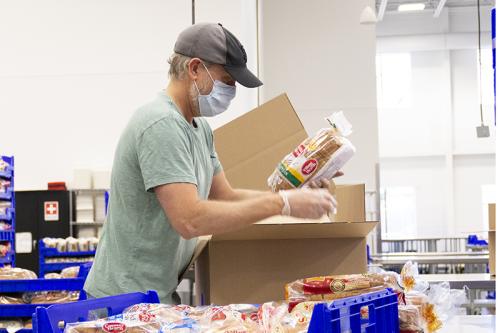
Preparing for the Surge in Hunger

When our new Brooklyn Park facility opened in April, I couldn’t have imagined that come July we’d be 10 years ahead of schedule filling the warehouse with food for our neighbors. It’s an emotionally conflicting moment.
As I reported back in early May, we’ve spent the past few months adjusting and reinventing our operations and programs in order to best respond to the emergency needs of our partners and communities impacted by the COVID-19 pandemic and recent uprisings.
This pivot included purchasing more food to meet demand, adapting distribution to accommodate curbside pickup models, waiving the costs of some products and services, and supporting several new or enhanced programs to increase access to nutritious food, like our emergency grocery pop-ups and Minnesota Central Kitchen.
All of this dynamic learning and rapid response, combined with new, local data predicting a historic and persistent surge in hunger, has prepared us to serve. Here's the latest:
Aligning with Partners
With this new data in hand, we immediately convened group discussions with our partners, enabling us to understand their specific anticipated needs and how we can best support them and their clients throughout the surge.
Readying our Operations
Our top priority is securing an additional 14 million pounds of food to cover anticipated demand through December 2020, all of which will need to be purchased rather than procured through donation or rescue given tightening supply chains.

In our new Brooklyn Park facility, we’ve experienced a 30% increase in our outbound distributions since the beginning of the pandemic and are preparing for increased volumes as we estimate that food banks and food shelves will experience a 65% increase in demand over this time last year from now to the end of 2020. We are extremely grateful for our warehouse team for more than rising to the occasion. They have truly served as essential personnel. Speaking of gratitude, one of our skilled volunteers built a prediction model that allows us to translate demand projections into staffing needs, providing real-time, data-driven operational response.
Meanwhile, our grocery stores food rescue operations continue to be strong, despite COVID-19 challenges faced by our partners.
With our transportation fleet at maximum capacity, we have engaged a third-party trucking company to help us meet surge volumes as well as the 126 large-scale food distributions, or emergency grocery pop-ups, that we added in June.
Staying Nimble
While it feels at times like we have settled into a new normal, nothing is predictable beyond knowing that this surge in need will persist for many, many months. But we’ve learned a great deal over the past four months, and we’ve built and tested a number of tools and systems to enable us to respond quickly, effectively and appropriately as circumstances require.
We remain continually grateful to our partners, donors, volunteers, staff and strong network of those commitment to ending hunger together.
